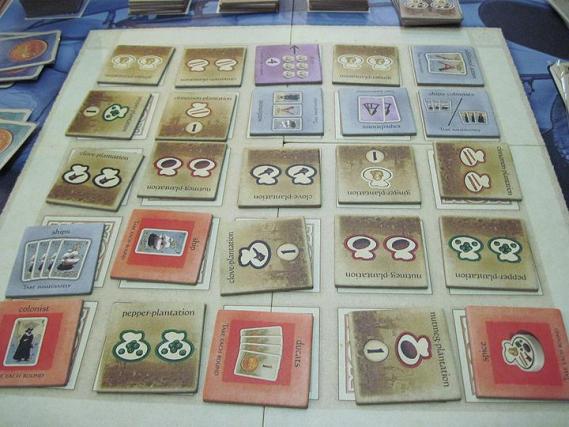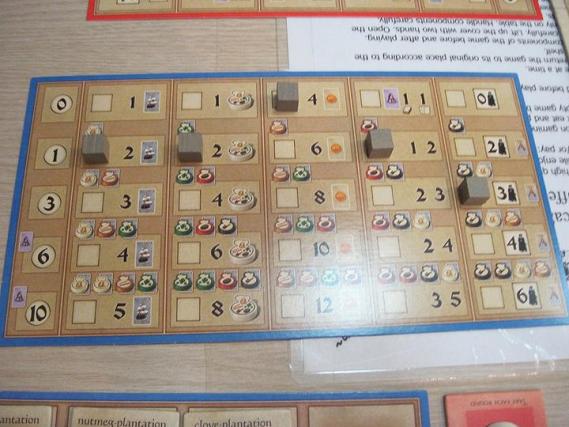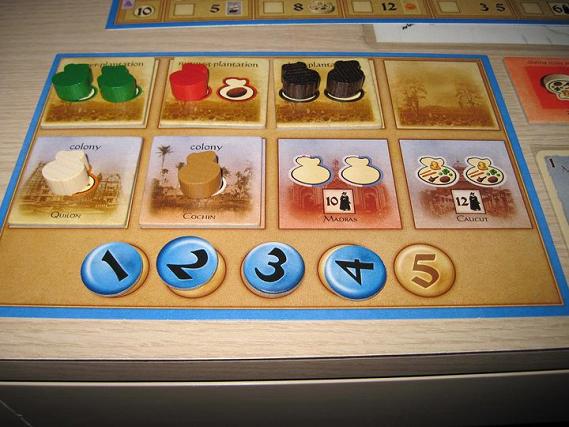
On a whim, I tried out the optimal game selection tool on BGG not too long ago, asking it for recommendations for a medium weight euro game suitable for two players. The only answer that popped out was Goa. It seems that this is a much sought after game that has been out of print for a while now despite the fact that it has a respectably high ranking on BGG. I’d have thought that these classics would be constantly in print since there’s obvious demand for them. Once again, I’m reminded of how small the boardgames industry really is.
The first thing that my wife said when presented with the game was to comment, “Wait, all this looks sort of familiar.” Indeed, there’s a distinct samey-ness about these Euros once we’ve had a few of them under our belts. This is evident not only in their mechanics but also in the themes that they choose and the general look of their components. It doesn’t change the fact that each is different enough to be distinctive in their own way, but the mutual resemblance is still unmistakable. That said, I found Goa to be an excellent game that certainly deserves its place on the BGG rankings. I am however amused that it’s somewhat deceptive what the game is all about.
I won’t spend too much time going over its rules, given that it’s such a well-known game. Each player has his or her own board which records his development across a series of tracks. One track for example, provides the player with increasing numbers of automatic colonists for colonization attempts. Another allows the player to produce increasing amounts of spices whenever the appropriate action is taken. During his turn, each player chooses to either develop a track, which costs resources in the form of spices and ships or perform an action associated with one of the tracks. So once you’ve developed the spice track to four spices for example, you get to produce four spices each time you take a production action, assuming you have the space for them.

The centrality of the various tracks is reinforced by the fact that the end of game scoring is based mostly on how far along each of the tracks each player has reached. Extra points are awarded based on how many colonies you have, who has the most money and the unused expedition cards left in hand at the end of the game, but as far as I can tell, most points come from advancing along the tracks. At the same time, advancing along the tracks improves the quality of the actions you can take, increasing the amount of resources gained from taking an action. This led me to believe that this game is about optimizing a particular mix of developments and actions to gain the most points.
This was a mistake however as I neglected the importance of the auction phase that preceded every round. These auctions are for the tiles that are laid down in a random manner on the main board at the beginning of the game. The tiles have a wide variety of uses. The most basic effect is the ability to hold one or more spices on them. Other tiles grants the player who gets them extra ships, colonists or expedition cards. Later tiles even give additional actions. One item that always appears in every auction is the start player token. In addition to starting first (not really a big deal in this game in my opinion), whoever gets this token, which is a flag, gains an extra action which I belatedly realized is a huge advantage and also gets to decide on which part of the grid of tiles the auction for the next round starts.
What threw me off is that the auction rules are completely different from any other game I’ve yet seen. The starting player chooses a spot on the grid to place the starting player flag and then places a token of his own color on top of it. The next player then chooses a tile next to the flag and places his own token on top of it and so on. Finally, the starting player places one additional token of his color on top of another tile. These colored tokens serve to denote who has a claim to the tile underneath. Whenever someone wins an auction for a tile and must pay the final bid, the money goes to the player who has a claim on that tile. If someone wins an auction for a tile that he has a token of his own color on, the money goes back to the bank.

This had some consequences that I was slow to grasp. You really only want to claim tiles that you don’t really need and suspect that other players strongly want. This is because you almost never want to win an auction for a tile that has a token of your own color on it. You might want to bid the price up but you need to be careful not to be stuck with it. Allowing others to win auctions for tiles with your tokens on them gives you money, which improves your bidding power in auctions. Winning one of your own auctions deprives you of this income and reduces the total money supply in the game, making every other player in the game effectively richer than you. This is an ingenious mechanic with quite subtle ramifications.
Anyway, I came in dead last because I didn’t understand how the auction phase should be played and paid attention only to the development tracks. There were turns during which I got nothing from the auction phase at all, which made my actions very inefficient, because I did stupid things like not valuing the start player flag highly enough and winning my own auctions, thus depleting my money supply. In retrospect the auction phase is by far the most important part of the game as the development tracks are quite straightforward. It is in effect what you win from the auction phase that should determine which actions are best to take during your turns.
Apart from this, I was also quite surprised by the mechanics involving tile distribution and expedition cards. Both introduce more randomness than usual for the typical euro game and I’m not sure yet how I feel about that. The expedition cards in particular seem to have a lot of variance. The right cards can be absurdly good at the right time while having only mediocre value at other times. I suppose it’s interesting to have such a development track in the game for players who like a bit of a gamble. All this appears to add replayability, but once again, it’s far too early for me to draw any solid conclusions. All I can say is for sure is that this is an intriguing game indeed. It’s deeper and more subtle that I first realized and it seems to be well-liked enough with just two players that I need to keep an eye out for it when it gets reprinted.
One Response to “Goa”
Trackbacks
Leave a Reply